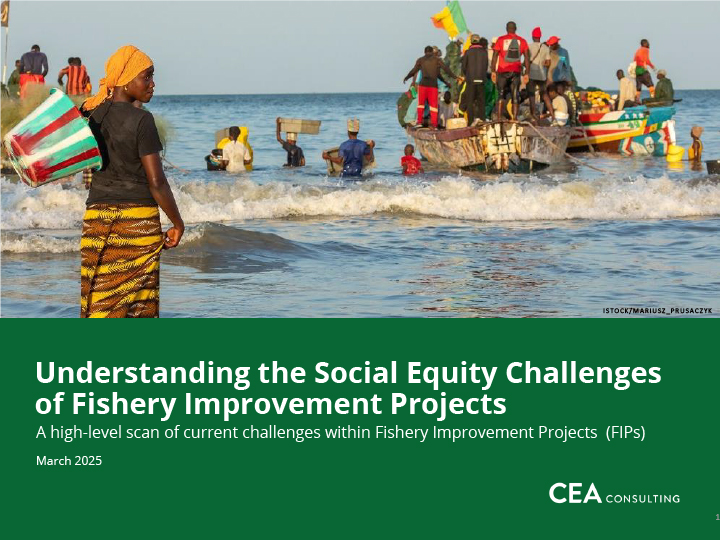
In June of 2024, CEA Consulting partnered with World Wildlife Fund (WWF) to conduct research to better understand the current equity challenges affecting fisheries participating in Fishery Improvement Projects (FIPs). Using a mixed-methods approach, CEA conducted interviews with 17 informants and deployed a survey to members of the FIP Community of Practice to gather a breadth of perspectives on the contextual, procedural, management, recognitional, and distributional equity conditions of the fisheries included in this study. Informants were also invited to share recommendations for how buyers could help address the identified challenges.
Highlights from the Report
Contextual Equity
Wild-caught fishing communities exist within complex socio-economic systems in which multiple social, economic, and political factors can magnify their vulnerability. These threats include:
- A lack of adequate public goods, such as drinking water, education, paved roads, health care, and social safety benefits;
- Insufficient or counterproductive government engagement that neglects or worsens fishers’ economic and social marginality;
- Intense competition over shared marine resources from the aquaculture, tourism, and renewable energy sectors;
- Organized crime activities that threaten fishers’ physical security;
- An increasing severity and frequency of natural disasters and the migration of fish stocks due to climate change; and
- Pervasive cultural attitudes that limit women’s broader participation and leadership in fisheries’ improvement efforts.
Support from civil society (including fisher cooperatives and NGOs) has proven critical to addressing these threats, though progress varies by FIP.
Procedural Equity
Generally, there appears to be insufficient fisher participation in fishery decision-making and management. Reasons for this include:
- Limited spaces exist for fisher input
- Material constraints (e.g., lack of Internet connection) prevent fishers from engaging in available decision-making fora.
Nevertheless, there have been examples of fishers aggregating to influence decision-making.
Managerial Equity
At the FIP level, fishers can play a consequential role in decision-making and often channel their voices through fisher cooperative leadership. As part of their social workplans, a growing number of FIPs are instituting mechanisms through which fishers can submit their grievances.
Recognitional Equity
While fishers appear to have an awareness of the rules and regulations that govern their fishery, broader awareness of their constitutional rights varies across the FIPs.
- In some cases, civil society and governments work to foster a culture of rights awareness among fishers.
- The broader culture of informality – especially for small-scale fisheries – can make securing formal human rights and labor protections challenging for many fishers.
- Fishers’ traditional knowledge has proven valuable to the development of effective fisheries management policies, but there remain difficulties in having this knowledge codified into law.
Distributional Equity
Though the greatest beneficiaries vary by context, industry appears to benefit the most from current fishery improvement efforts while fishers and women see the fewest benefits from their participation in FIPs. In a few cases, fisher groups, particularly older male fishers, have been able to capture greater benefits than other fishers, particularly women and youth. Often, fishers shoulder the financial burdens of environmental sustainability improvements and have reduced access to traditional fishing grounds. Because many women occupy post-harvest roles (or have been pushed out of fishing), they cannot enjoy the same access to product as their male fisher counterparts. In terms of potential effects of FIPs on local access to fish, the results vary. For some FIPs, local demand (and price) is greater than that of exporters and so product is sold into local markets (with some product additionally exported, based on demand). In other cases, fishers receive greater financial benefits when they sell to the export market but there are no perceived negative impacts on local food security. There were a few exceptions where export market demand has been detrimental for local consumption.
Buyer Recommendations
In general, interviewees agreed that greater industry support for FIPs was needed. Informants offered a range of recommendations to help bolster industry engagement that broadly fall into four buckets:
- Instituting fair and transparent pricing practices (among trading partners) that ensure an equitable distribution of benefits and enhance the bargaining power of fishers to set prices;
- Generating demand for FIPs through strong market commitments and supplier policies that ensure FIPs can access the market and see financial returns on their improvement efforts;
- Investing in and engaging with fishers as trusted partners in fisheries improvement efforts, and working closely with government and civil society organizations; and
- Bolstering the capacity of fishers to grow their business and management potential, especially as a means to: 1) drive social improvements; and 2) improve their capacity to engage with and learn from market actors.
Download the report for a full summary of the study’s findings.
